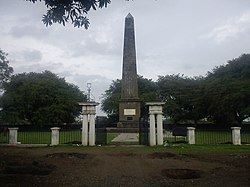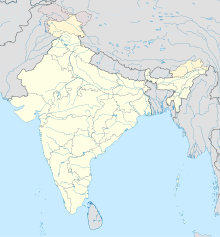Battle of Koregaon
| Battle of Koregaon | |||||||
|---|---|---|---|---|---|---|---|
| Part of Third Anglo-Maratha War | |||||||
|
Bhima Koregaon Victory Pillar |
|||||||
|
|||||||
| Belligerents | |||||||
|
|
|
||||||
| Commanders and leaders | |||||||
| Captain Francis F. Staunton |
Peshwa Baji Rao II Bapu Gokhale Appa Desai Trimbakji Dengle |
||||||
| Units involved | |||||||
| 2nd Battalion of the 1st Regiment of Bombay Native Infantry Madras Artillery |
Arabs, Gosains and Maratha | ||||||
| Strength | |||||||
| 834, including around 500 infantry, around 300 cavalry and 24 artillery 2 6-pounder cannons |
28000, including 20,000 cavalry and 8000 infantry (around 2,000 participated in the battle supported by 2 cannons) |
||||||
| Casualties and losses | |||||||
| 275 killed, wounded or missing | 500–600 killed or wounded (British estimates) | ||||||
|
|
|||||||
The Battle of Koregaon was fought on 1 January 1818 between the British East India Company and the Peshwa faction of the Maratha Confederacy, at Koregaon Bhima. The 28,000-strong Marathas, led by Peshwa Baji Rao II intended to attack Pune. On their way, they were met by an 800-strong Company force that was on its way to reinforce the British troops in Pune. The Peshwa dispatched around 2,000 soldiers to attack the Company force stationed in Koregaon. Led by Captain Francis Staunton, the Company troops defended their position for nearly 12 hours. The Marathas ultimately withdrew, fearing the arrival of a larger British force led by General Joseph Smith.
The Company troops included predominantly Mahar Dalit soldiers belonging to the Bombay Native Infantry, and therefore the Dalit activists regard the battle as a heroic episode in Dalit history.
By the 1800s, the Marathas were organized into a loose confederacy, with the major constituents being the Peshwa of Pune, the Scindia of Gwalior, the Holkar of Indore, the Gaekwad of Baroda, and the Bhonsle of Nagpur. The British had subjugated and signed peace treaties with these factions, establishing Residencies at their capitals. The British intervened in a revenue-sharing dispute between the Peshwa and Gaekwad, and on 13 June 1817, the Company forced Peshwa Baji Rao II to sign an agreement renouncing claims on Gaekwad's reveues and ceding large swaths of territory to the British. This treaty of Pune formally ended the Peshwa's titular overlordship over other Maratha chiefs, thus officially ending the Maratha confederacy. Soon after this, the Peshwa burnt down the British Residency at Pune, but was defeated in the Battle of Khadki near Pune on 5 November 1817.
...
Wikipedia


